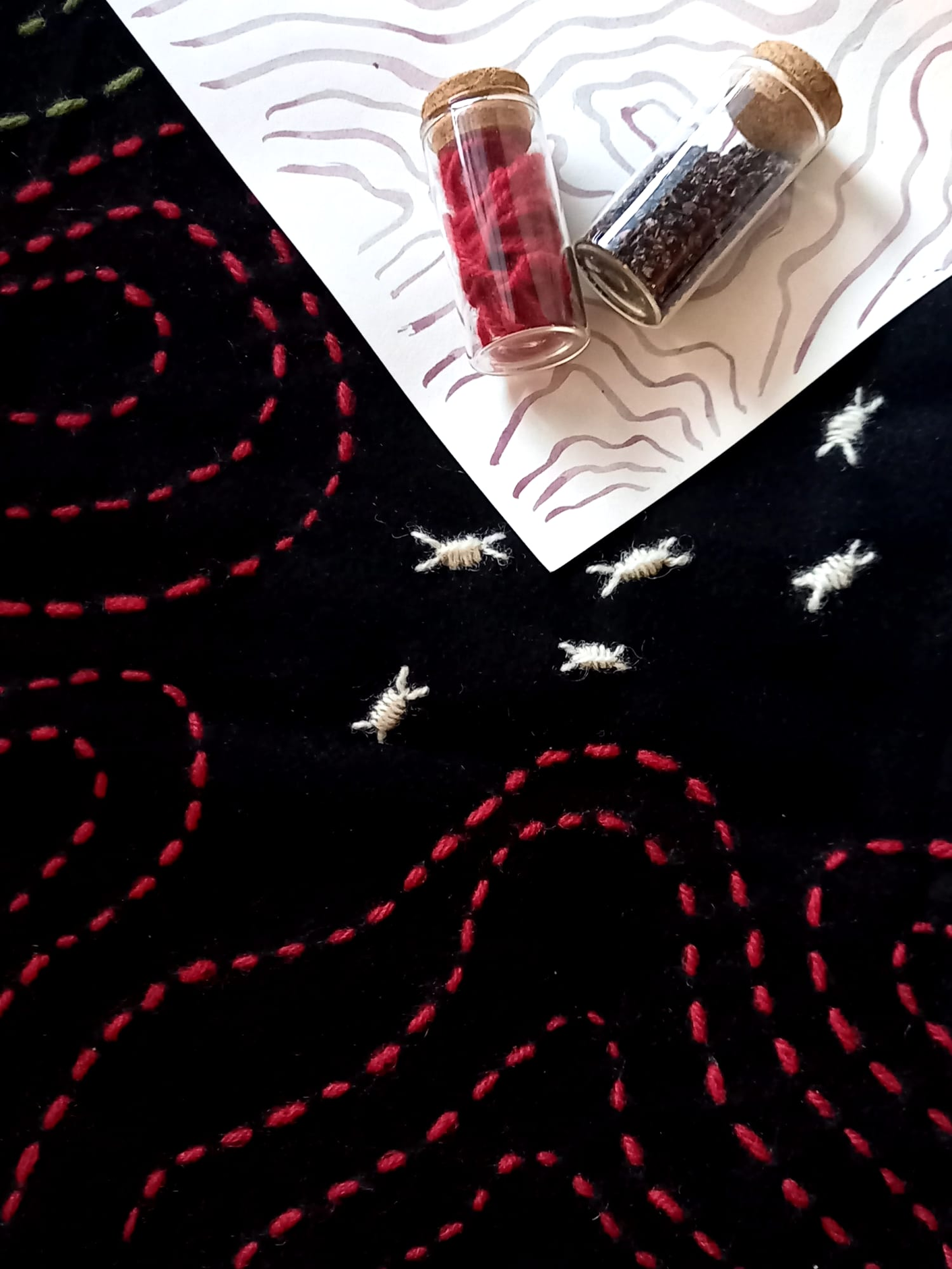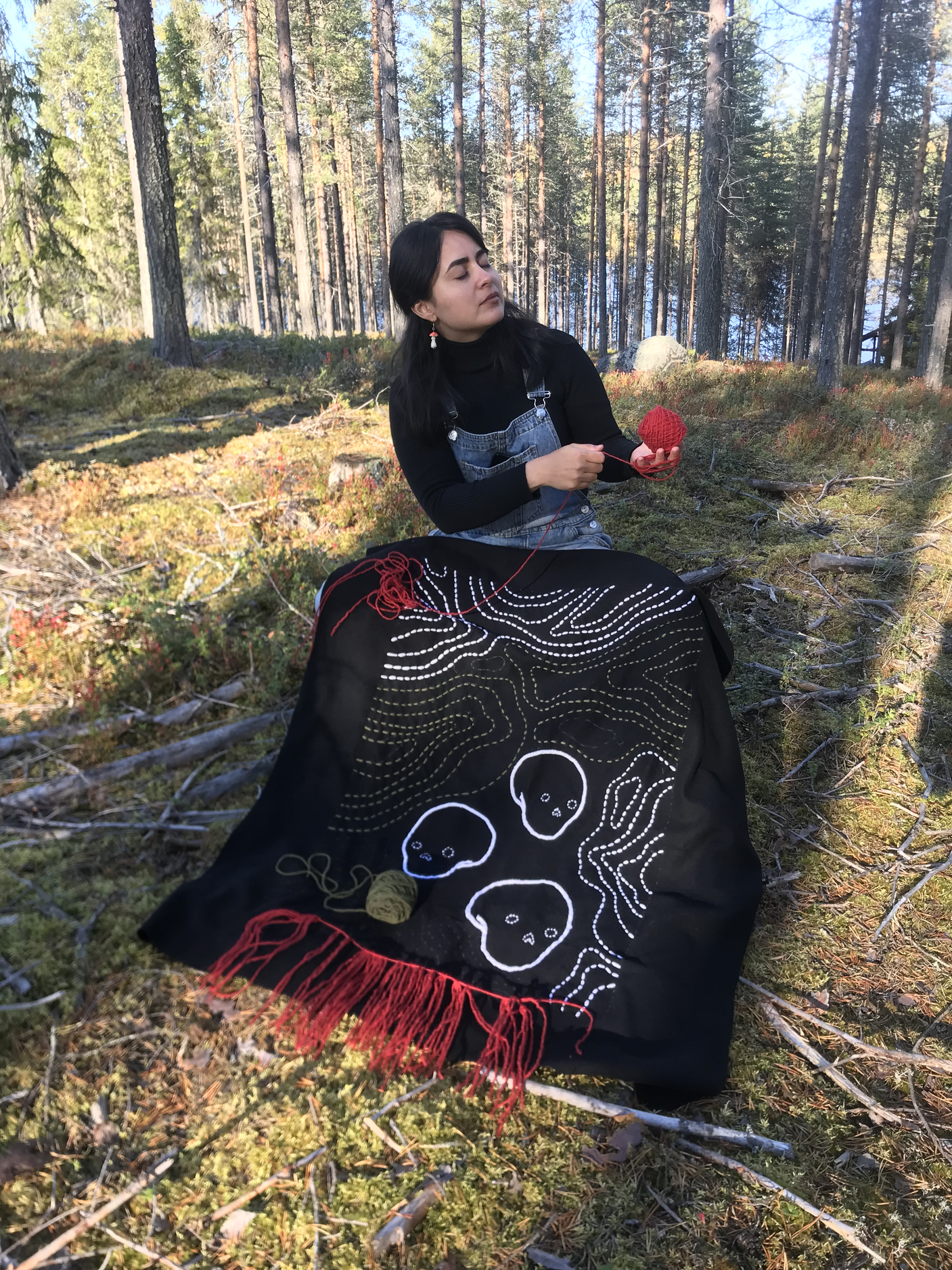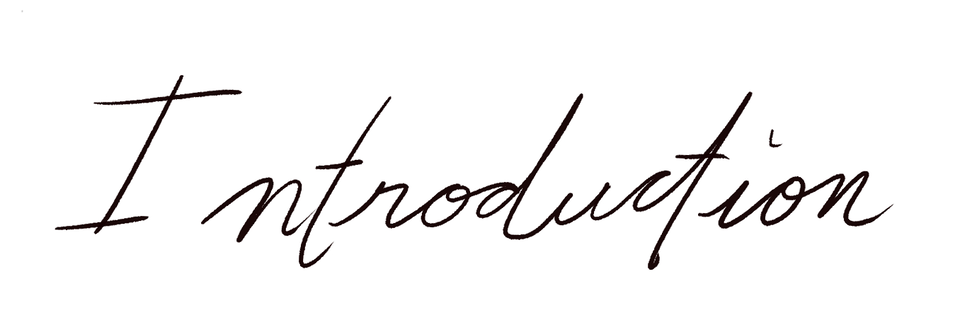Fig. 2 Cervantes´s first piece for the Embroidered Stances project, the picture depicts a close-up of the embroidered insects next to glass bottles containing dried cochineal insects and dyed yarn. Photographed by Cervantes, 2023.
Fig. 1 First author Cervantes at one of the Embroidered Stances session at Huhmarniemi´s cottage during the summer of 2022. Photographed by Huhmarniemi, 2022.
When Mexican Fabiola Hernandez Cervantes was researching Arctic wool and its connections with traditional and contemporary crafts in Finland, an opportunity led her to a textile crafter who dyes wool using cochineal insects (Cervantes, forthcoming). Cervantes knew the history of using cochineal for dyeing as one of the most important and millenary practices of Indigenous knowledge in Mexico; thus, she began a journey to create and study connections between the Arctic region, Indigenous knowledge, contemporary art and craft conceptualisation.
Cervantes’s research follows the approach of art-based action research (ABAR), in which the revitalisation of traditional knowledge and various forms of collaboration and craftivism are developed in cycles of artistic practice and reflection. In this exposition, a research diary by Cervantes and documents of artistic practices (figure 1-2) are used as research data to consider aspects of craftivism, revitalisation of traditional knowledge and new material ways of knowing and making. Artistic research aims to contribute to the development of a more sustainable and lively craft field in the province of Lapland, Finland, in the Arctic region and beyond.
This exposition is theoretically based on studies on contemporary crafts (Adamson, 2010; Ravetz et al., 2013) and new materialism (Barrett & Bolt, 2013; Fox & Alldred, 2019; Gamble & Hanan, 2019; Garber, 2019) that is an interdisciplinary, theoretical, and politically committed field of inquiry, that can be called also as material turn. In this study, matter—dried cochineal insects and Finnish wool—is not considered merely subject to human actions but as an element that enables interactive relationships between humans and other-than-human agencies. In the realm of art and crafts, humans frequently utilize materials derived from animals, including cochineal insects, silkworms, Shellac dye from lac insects (Kerria lacca), fur, and animal skins. The concept of speciesism, rooted in the belief of human superiority over other species, has long permeated society, influencing various human activities, particularly our interactions and utilization of non-human organisms. However, the concept of anti-speciesism (Sueur, 2019; Ryder, 2010) is closely associated with posthumanism and endeavors to challenge hierarchical perspectives while advocating for ethical consideration of all living beings.
In this pursuit, both authors aim to foster a more comprehensive understanding of the intricate relationships between humans and animals within the context of artistic expression and the pursuit of sustainability in the artistic realm. By delving into the multifaceted interactions between humans and animals, this research seeks to promote awareness of the ethical dimensions involved in our artistic practices. Moreover, the study aims to contribute to the growing discourse on anti-speciesism, acknowledging the value of all living beings and their significance in the pursuit of sustainable artistic endeavors.
Following the approach of Arctic art (Huhmarniemi & Jokela, 2020a, 2020b), Western categories of art, crafting and design are not followed in this practise of Embroidered Stances collective nor in this exposition. As Sinner and Yazdnapanah (2021) described, crafting-art collectives can raise awareness of diverse ways of making, sharing and producing art, and thus craftivism is also a kind of activism and art education about art.
Discussion on revitalisation, a process that aims to restore the value of old traditions in a contemporary context (Auclair & Fairclough, 2015), inspired this practice-led research on collaborative craftivism and the use of cochineal. Several action-research projects and reports have served as examples of how to promote the revitalisation of traditional knowledge and cultural heritage (Cunsolo et al., 2017; Huhmarniemi & Jokela, 2020a; Härkönen et al., 2018; Jokela & Huhmarniemi, 2021; Jokela & Huhmarniemi, 2022; Uzawa, 2019; Tung, 2012). Knowledge transformation from Indigenous cultures to contemporary practice is considered potentially beneficial for sustainability, and the ethics of the practice are discussed by considering the history of trade and the global crafting tradition.
Huhmarniemi, the second author of this exposition, initiated the revitalisation of wool embroidery into craftivism and invited artists, crafters and activists to join the creative collaboration. This initiative has grown into a collective of 14 artists, crafters, activists and artist-researchers working under the title Embroidered Stances. In the Finnish language, the title or the project “Kirjotut kannat” refers to embroideries as arguments and statements, and this project is rooted in activist approaches in contemporary art: craftivism (Huhmarniemi, 2021; Keune et al., 2021; Nordenstam & Wictorin, 2021) and artivism (Aladro-Vico et al., 2018). Each participant creates his or her personal and political statement embroidering wool yarn on woollen fabric, thus creating embroidered blankets. Also, the word “kannat” refers to cultural roots and ancestral cultures. The word “kanta” in the Finnish language translates as ancestral, and participants also reflect their cultural roots in the embroideries. The Embroidered Stances collective uses wool fabric and hand-dyed Finnish wool yarn to revitalise the tradition of blanket embroidery. Similar crafts have been made in many countries; in Finland the traditions started in the late 1700s. This exposition presents Cervantes’s contribution to the Embroidered Stances project.
This exposition is co-authored by two scholars, while the first author, Cervantes, conducted the research, the second author, Huhmarniemi, contributed to framing the conceptual and theoretical reflection and discussion on the practice and thematics of research: new materialism, craftivism, activism and decolonisation. In this exposition, a research diary by Cervantes documents her artistic practice, serving as research data, and visual illustrations are presented along with text-based discussion and conceptualisation. The materiality expressed through the images aims to create an integrative representation that makes discussions on theoretical concepts and complex issues tangible. The presentation of artistic practice aims to generate discussions on methods and knowledge as well as the identification of new questions for future inquiries.
Cervantes moved to Lapland after she grew up in Mexico and lived in Southern and Eastern Europe. The research was conducted in the province of Lapland and at the University of Lapland. Both the city of Rovaniemi and the university, with its Faculty of Art and Design, are a cultural melting pot since tourism as well as educational institutions bring new people to Lapland from all over the world. Research interest in Arctic art and Arctic sustainability includes traditional Indigenous and other land-based approaches and contemporary collaborative art forms. The process of transculturation has been approached through artistic practice that brings the arts and cultures of newcomers and long-term locals into a dialogue or blend in Lapland (Hiltunen et al., 2020; Huhmarniemi & Hiltunen, 2022).
In Finland, the home land of the Indigenous Sámi people is located in the province of Lapland. The relevance of investigating colonisation, Indigenous knowledge and knowledge appropriation in this context is particularly significant. Indigenous knowledge has been approached by Sámi research from both practical and conceptual perspectives (Bydler, Eriksen et al., 2017; Valkonen & Valkonen, 2014). Moreover, recent studies have focused on human-animal relations, which carry on from traditional practices to contemporary cultures (Kuokkanen 2023, Nyyssönen & Salmi, 2013; Äijälä, 2022).
An approach rooted in posthumanism towards human-animal relationships acknowledges the agency of non-living animals, while certain studies also address concerns related to cultural sustainability. For instance, the practice of touristic dog sledging is often deemed culturally unsustainable and conflicting with traditional Sámi reindeer herding (Äijälä, 2022). Consequently, sled dogs might be seen as a culturally invasive alien species in Sápmi (Äijälä 2022). Research on reindeer Herding in Sápmi consideres how reindeers are being threatened by the renewable energy transition (Kuokkanen 2023).
This study aims to contribute to the understanding of how non-Indigenous crafters engage with colonial history and current cultural assimilation and appropriation, reflect on the ethical aspects of their cultures, and explore the potential of sustainability through embracing Indigenous knowledge. Anyhow, it is essential to clarify that this research does not aim to contribute to Indigenous research nor offer recommendations; rather, it seeks to foster an enhanced comprehension of the complexity of materialism, sustainability, activism and knowledge sharing in the era of globalisation.


